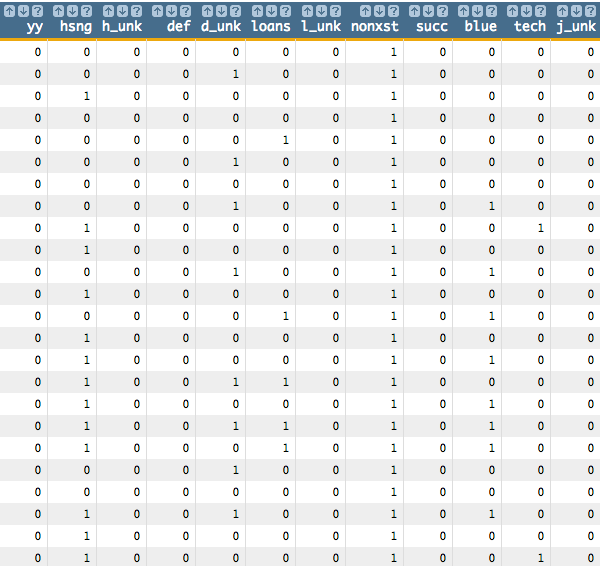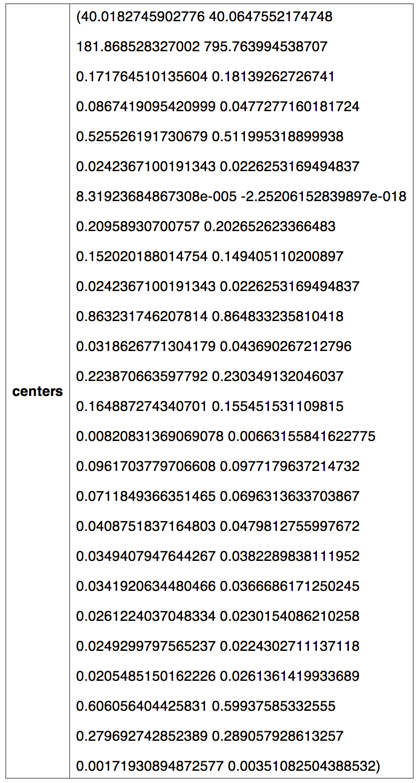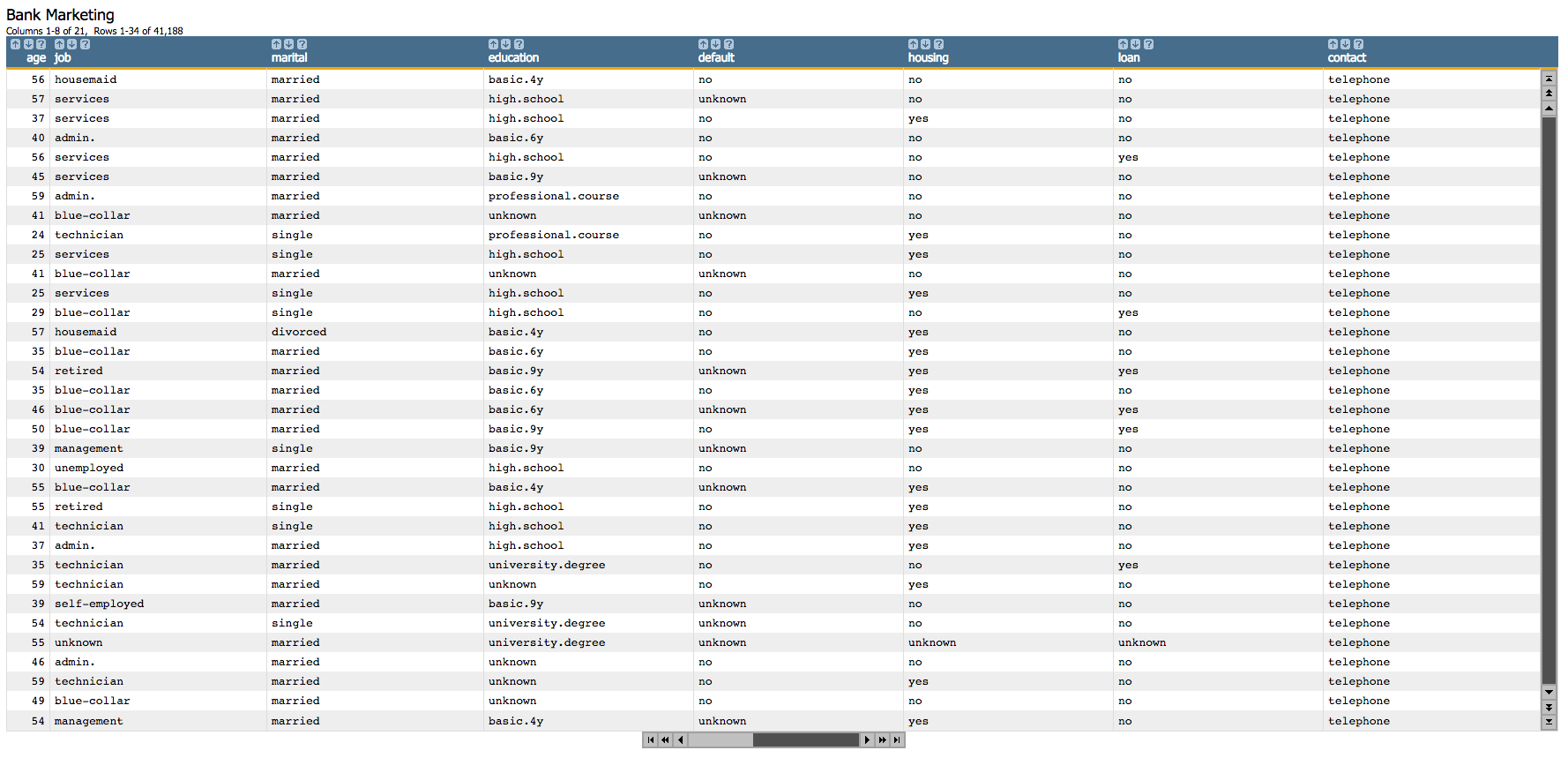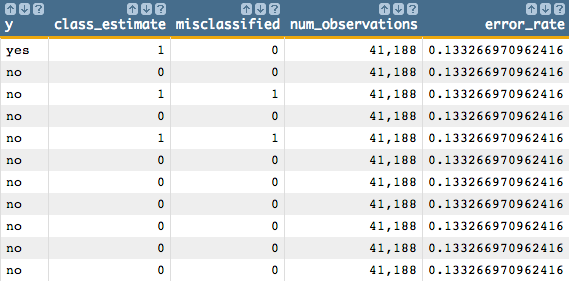In this example, clustering is used to separate a data set containing bank marketing
information into two classes. The clustering results are then examined to see if they
accurately reflect the underlying pattern in the data set, which in this example is whether
or not a customer subscribed for a term deposit.
Clustering, using the 1010data function g_cluster(G;S;XX;A;N;Z), will be
performed on the Bank Marketing Data Set. This data set contains information
related to a campaign by a Portuguese banking institution to get its customers to subscribe
for a term deposit.
The clustering algorithm uses the following 10 variables in that data set:
agedurationpreviousempvarratehousingdefaultloanpoutcomejobmarital
Clustering is unsupervised learning, which means we assume there is no label for each
observation. However, after running the clustering algorithm, we could compare the
value of column y (whether someone subscribed for a term deposit)
with our clustering results to see if our algorithm found the underlying pattern of
data.
This analysis will follow the following steps:
- Prepare the data by creating dummy variables for each of the categorial
columns (since we cannot use textual data to build our model).
- Run k-means clustering on the continuous variables in the original data set
and the dummy variables that we created, partitioning the data into two
classes.
- Classify the results of the clustering.
- Obtain the center of each class in various dimensions.
- Chart the two classes and plot their centers.
- Calculate the error rate by determining the percentage of observations that
are misclassified.
-
Open the Bank Marketing data set
(pub.demo.mleg.uci.bankmarketing).
-
Since we cannot use textual data in our analysis, we first create dummy
variables for each of the categorial columns.
<willbe name="yy" value="y='yes'"/>
<willbe name="hsng" value="housing='yes'"/>
<willbe name="h_unk" value="housing='unknown'"/>
<willbe name="def" value="default='yes'"/>
<willbe name="d_unk" value="default='unknown'"/>
<willbe name="loans" value="loan='yes'"/>
<willbe name="l_unk" value="loan='unknown'"/>
<willbe name="nonxst" value="poutcome='nonexistent'"/>
<willbe name="succ" value="poutcome='success'"/>
<willbe name="blue" value="job='blue-collar'"/>
<willbe name="tech" value="job='technician'"/>
<willbe name="j_unk" value="job='unknown'"/>
<willbe name="svcs" value="job='services'"/>
<willbe name="mgmt" value="job='management'"/>
<willbe name="ret" value="job='retired'"/>
<willbe name="entr" value="job='entrepreneur'"/>
<willbe name="self" value="job='self-employed'"/>
<willbe name="maid" value="job='housemaid'"/>
<willbe name="unemp" value="job='unemployed'"/>
<willbe name="stud" value="job='student'"/>
<willbe name="marr" value="marital='married'"/>
<willbe name="sgl" value="marital='single'"/>
<willbe name="m_unk" value="marital='unknown'"/>
These <willbe>
operations create a computed column for each of the categories, where a
1 in the column indicates that the category
is true for that row. For instance, in the following screenshot, the rows
where hsng=1 indicate that the
client had a housing loan (i.e.,
housing='yes' in the original
table), and the rows where
h_unk=1 indicate that it
is unknown if the client had a housing loan (i.e.,
housing='unknown').

See Dummy Variables for a list of the dummy variables used here and their meanings.
-
Using
g_cluster(G;S;XX;A;N;Z), we run k-means clustering
on the continuous variables in the original data set and the dummy variables
that we created. Using the N argument, we specify that we want
to partition the data into two classes.
<note>CLUSTER WITH 26 VARIABLES</note>
<willbe name="model_cluster" value="g_cluster(;;age duration previous
empvarrate hsng h_unk def d_unk loans l_unk nonxst succ blue tech
j_unk svcs mgmt ret entr self maid unemp stud marr sgl m_unk;'kmeans';2;)"/>
This creates a column named model_cluster that contains the
results of the clustering:

Clicking on the > opens a window containing a summary of the
model output:

-
We can then classify the results of the clustering by using the
classify(XX;M;Z)
function.
<willbe name="class_estimate" value="classify(age duration previous
empvarrate hsng h_unk def d_unk loans l_unk nonxst succ blue tech j_unk
svcs mgmt ret entr self maid unemp stud marr sgl m_unk;model_cluster;)"/>

The two classes that result from our clustering algorithm have the values
0 and 1 in the
class_estimate column.
-
Let's obtain the center of each class for the various dimensions (e.g.,
age, duration, previous)
using the param(M;P;I)
function.
For instance, param(model_cluster;'centers';2 1) gives us
the second dimension of the first class. (In our example, the
second dimension is duration.)
So the following will give us the first three dimensions of both classes:
<willbe name="center_class_1_1" value="param(model_cluster;'centers';1 1)"/>
<willbe name="center_class_2_1" value="param(model_cluster;'centers';2 1)"/>
<willbe name="center_class_3_1" value="param(model_cluster;'centers';3 1)"/>
<willbe name="center_class_1_2" value="param(model_cluster;'centers';1 2)"/>
<willbe name="center_class_2_2" value="param(model_cluster;'centers';2 2)"/>
<willbe name="center_class_3_2" value="param(model_cluster;'centers';3 2)"/>
-
Finally, we can visualize the results of the clustering algorithm using the
1010data Chart Builder.
-
Create two columns for each class corresponding to the
age and duration columns.
Note: Rows that contain N/A values will not be charted in
1010data.
<willbe name="cluster_1_age" value="if(class_estimate=0;age;NA)"/>
<willbe name="cluster_1_duration" value="if(class_estimate=0;duration;NA)"/>
<willbe name="cluster_2_age" value="if(class_estimate=1;age;NA)"/>
<willbe name="cluster_2_duration" value="if(class_estimate=1;duration;NA)"/>
-
Click .
-
To visualize the first class, drag the
cluster_1_age
column to the DATA (X-AXIS) area and
cluster_1_duration to the DATA
(Y-AXIS) area.
-
To visualize the second class, drag
cluster_2_age to
DATA (X-AXIS) and
cluster_2_duration to DATA
(Y-AXIS).
-
To plot the center of the first class, drag
center_class_1_1 to DATA
(X-AXIS) and center_class_2_1 to
DATA (Y-AXIS).
-
To plot the center of the second class, drag
center_class_1_2 to DATA
(X-AXIS) and center_class_2_2 to
DATA (Y-AXIS).
-
To set the colors for the classes and their centers, under the
DATA SERIES section of the Customization Settings panel,
enter the following in the Colors field:
#c0504d;#000000;#c0504d;#000000
-
To set the scatter point sizes for the classes and their centers, under
the DATA SERIES section of the Customization
Settings panel, enter the following in the Scatter point
sizes field:
small,small,large,large
-
Click Update.
The results should look similar to the following chart:

In the above chart, the red scatter points represent one class, and the black
scatter points represent the other. The larger red and black scatter points
represent the centers of those classes.
-
We can calculate the error rate by determining the percentage of observations
that are misclassified; that is, we can compare the clustering results to see if
they accurately reflect the underlying pattern in the data set, which in our
example is whether a customer subscribed for a term deposit or not.
It looks like, for the most part, the cluster with the value
0 for class_estimate looks
like it matches up with those values in y whose values are
no, and the cluster with the value
1 for class_estimate looks
like it matches up with those values in y whose values are
yes.
Let's find the number of observations in which neither of these cases is true
to flag those observations as misclassified. Then we'll divide that number
by the total number of observations to find the error rate.
<willbe name="misclassified" value="(y='no'&class_estimate=1)|(y='yes'&class_estimate=0)"/>
<willbe name="num_observations" value="n_"/>
<willbe name="error_rate" value="g_cnt(;misclassified)/num_observations"/>








